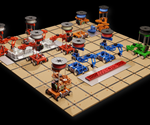Why Robots and Additive Manufacturing Go Together
3D printing and robots enable one another. We miss the possibilities of one if we do not consider the other. The combination includes AM for end effectors, robots for 3D printing parts, and different modes of metal and plastic production.
With additive manufacturing (AM), there is essentially no force. That is, there is no bending, forming, pressing or cutting forces, unlike other part-making operations. This lack of force will have a big impact, because it changes the possibilities for the kind of equipment now able to make parts. Specifically, forceless fabrication expands the possible role for a long-established piece of industrial equipment: the robot.
Addere illustrates this. This developer of robot-based metal AM systems was spawned from an automation integrator that has long supplied robots into CNC machining operations, but generally for moving parts instead of making them. A robot by its nature is an unsupported arm, poorly suited to cut metal directly because the forces are generally too high. A rigid machine tool is needed instead. However, adding metal is not like metal removal—the forces here are slight. As a result, through the work of Addere and others, robots are now finding a role making parts.
But this is just one example of a larger collaboration. Because of AM, robots are now extending their reach in various ways. Conversely, thanks to robots, AM is adding layers. These two technologies leverage one another. They work together in ways that make each of them more capable.
How many ways? Together, several recently posted articles tell the story. A catalog of the ways robots and AM work together includes all of the following:
1. Integration. AM aids robots in the work they have done all along: part loading and material handling. As Thyssenkrupp Bilstein discovered, AM provides the natural way to make end-of-arm tooling tailored to the job, speeding and simplifying robot integration.
2. Production. By building additively via directed energy deposition (DED), robots can make production parts. Addere’s applications have focused on big parts. Formalloy shows a different possibility: The robot performing DED could also be a means of continuous production, perhaps with a conveyor carrying away parts as they are built.
3. Coordination. Maybe the weirdest recent robot story: Mobile robots working additively could coordinate their efforts. Researchers at the University of Arkansas expect small, mobile AM robots to offer an option for 3D printing large objects by dividing the form into interlocking regions and organizing to perform the build as a swarm.
4. Disruption. Then there is our recent story describing how injection molder Evco Plastics has now realized a method of plastic parts production that is far different from injection molding. A cobot performing unattended unloading of parts from an array of small, desktop 3D printers has given this company a system for low-cost, lights-out production in which no mold tooling is needed, redefining the kinds of plastic parts that now can be produced cost effectively.
This automated AM system at Evco would have been hard to foresee when the company first started using 3D printing. Ditto, the possibility of making parts with a robot alone, as Addere and Formalloy are doing, would have been hard to foresee before AM arrived. A technology does not realize its promise in isolation. We have to consider the technologies that touch it, the ones that will enable and affect it. AM lets robots do more. Robots let AM do more. These two technologies will advance together. These two technologies have been waiting for one another.
Related Content
This Drone Bird with 3D Printed Parts Mimics a Peregrine Falcon: The Cool Parts Show #66
The Drone Bird Company has developed aircraft that mimic birds of prey to scare off problem birds. The drones feature 3D printed fuselages made by Parts on Demand from ALM materials.
Read MoreCopper, New Metal Printing Processes, Upgrades Based on Software and More from Formnext 2023: AM Radio #46
Formnext 2023 showed that additive manufacturing may be maturing, but it is certainly not stagnant. In this episode, we dive into observations around technology enhancements, new processes and materials, robots, sustainability and more trends from the show.
Read MoreActivArmor Casts and Splints Are Shifting to Point-of-Care 3D Printing
ActivArmor offers individualized, 3D printed casts and splints for various diagnoses. The company is in the process of shifting to point-of-care printing and aims to promote positive healing outcomes and improved hygienics with customized support devices.
Read More6 Trends in Additive Manufacturing Technology at IMTS 2024
3D printers are getting bigger, faster and smarter. But don’t overlook the other equipment that the AM workflow requires, nor the value of finding the right supplier.
Read MoreRead Next
Automated 3D Printing at Evco: Composites, Cobots, Email and More
Injection molder Evco has long seen the importance of industrial automation for plastics processing. Its latest automation feat? A cobot-tended cell of 3D printers for manufacturing fixtures and customer products unattended.
Read MoreRobots, Assemble! A New Path to Autonomous Mobile 3D Printing
Robot swarms may sound alarming, but research at the University of Arkansas reveals that they may enable a new, ultra-efficient era of automated manufacturing and 3D printing.
Read MoreThe Promise of Robotic Metal Additive Manufacturing
Addere’s robot-based laser system builds using standard weld wire. The company was spawned from a robot integrator, and that background has been valuable for both overcoming the challenges and perceiving the possibilities of using a robot for metal 3D printing.
Read More




















